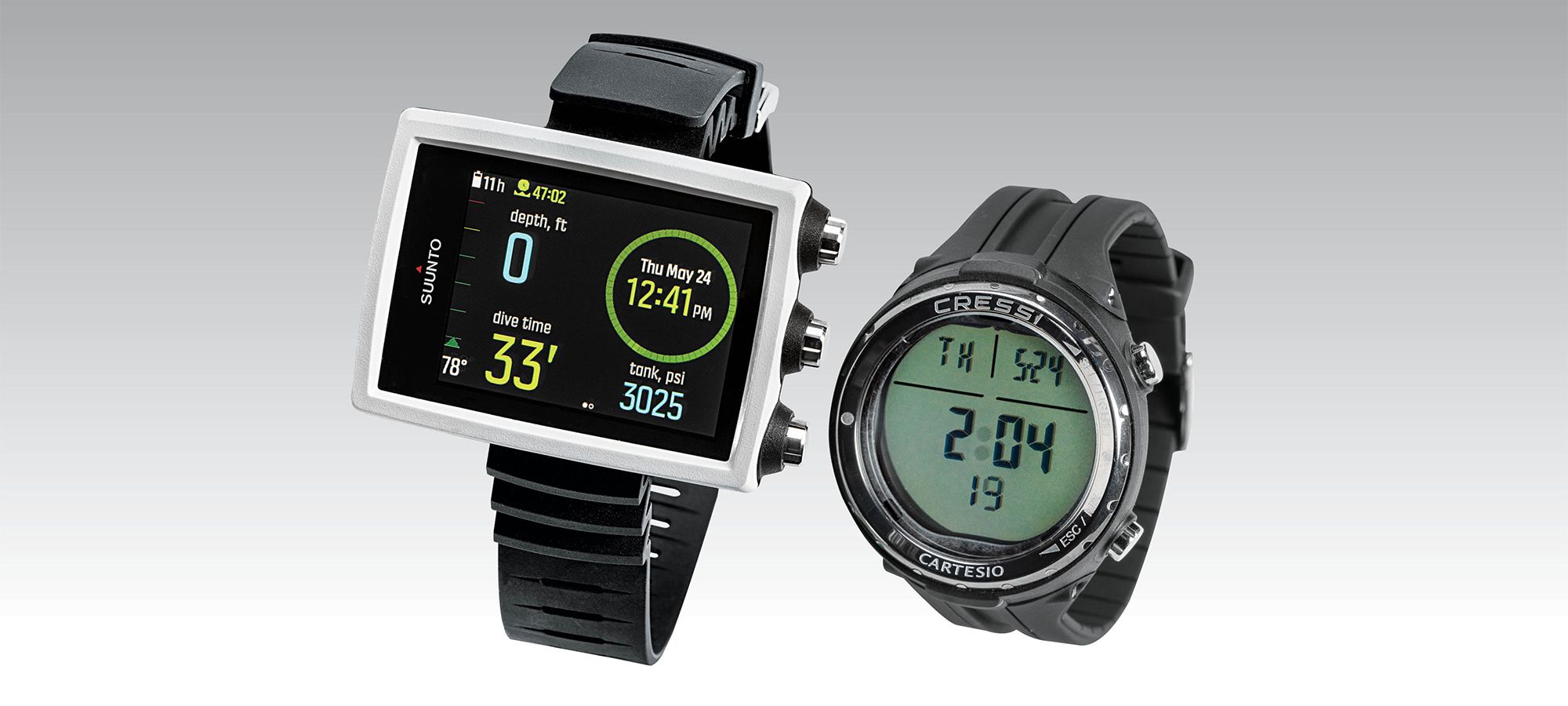Dive Computers
Learn how a dive computer works and what to look for when buying a new dive computer.

Dive Computer
Dive computers have to be atop most divers’ list of favorite scuba gear. Why? Simply because they've made physical dive tables all but obsolete. Dive computers calculate your no-decompression time using their internal algorithms that factor in real-time information such as your depth, dive time, repetitive dives, water temperature, no-decompression time and more. Air-integrated dive computers connect to your tank in order to display your remaining tank pressure. Some computers can use this info in their no-deco calculations and estimate your remaining gas time.
ScubaLab tests new dive computers each year with a team of test divers evaluating them for ease of operation, ergonomics and more, and with the experts at the USC Catalina Hyperbaric Chamber simultaneously subjecting dive computers to simulated dive profiles to gauge the relative liberalism or conservatism of their algorithms. Check out ScubaLab’s latest dive computer review here.
What’s the Difference Between a Dive Watch and a Dive Computer?
Some people confuse dive watches for dive computers. Here’s the difference: Dive watches are timepieces that are specially made to withstand the pressure at depth for scuba diving (usually considered watches depth-rated to at least 100 meters). They are used to track bottom time. Dive computers are electronic and calculate your no-decompression limit using your depth and other key features by evaluating your dive profile against an internal algorithm, allowing you to stay within safe dive limits.
What to Consider When Choosing a Dive Computer
There are many types of dive computers, many of which are designed for specific types of diving. Some computers support multiple gas mixes for technical divers, cramming loads of information on the display knowing the user can handle it. Others offer the basics, providing clear and simple information so a beginner doesn’t get overwhelmed. Here are a few dive computer features to consider before you buy.
What style dive computer do you want?
Console Dive Computer: This type connects to your regulator via a high-pressure hose like traditional mechanical-gauge consoles, but it provides depth, air and dive data on a digitized screen. These are popular because divers are accustomed to the console concept, plus they use extra-large screens that are easy to read at depth.
Wrist-Mount and Watch-Style Dive Computer: While more compact than console computers, wrist-mounts still provide easy-to-read screens. An even smaller version is the watch style, which combines the time-keeping functions of a topside watch with dive-computing functions.
What is an air-integrated dive computer?
Air integration lets you monitor air consumption and dive status simultaneously on the screen of your computer. Normally found on console computers, this feature is also available on some wrist-mount models with hoseless transmitters.
What features do you want on your dive computer?
The dive computer’s buttons are what allow you to navigate through its menu systems. Generally, the more buttons there are, the easier it is to set programming parameters and move from one mode to another. It should be easy to read and understand the primary dive screen. Depth and no-decompression limits are considered the most important information a diver needs while underwater, so on most computers, this data is the most prominent on the screen, displayed in large, bold digits. Make sure it’s easy to access alternate screens and after-dive data, and that the computer has the features you want, such as audible and/or visual warnings and easy-to-read safety-stop countdown. Also, many dive computers offer Bluetooth capabilities allowing you to easily log your dives on a connected app after you surface.
What is a dive computer algorithm?
Basically, a dive computer’s algorithm is a formula it uses to take your dive information — depth and time — and run those numbers against its model (dive tables) to calculate your safe diving limits. Do you understand how your computer’s algorithm works? You needn’t be a math whiz for this; you only need to know where the dive computer falls on the conservative/liberal scale. If it’s more important for you to maximize your bottom time, you’ll want a more liberal model. If you want to build in a cushion of safety, choose a conservative model. ScubaLab’s latest review tests the latest computers in a hyperbaric chamber to see where its algorithm falls on the scale.
